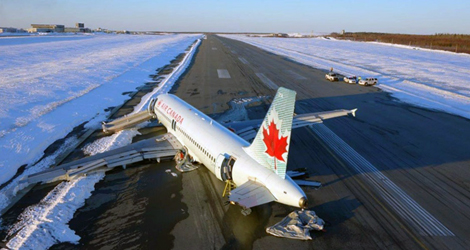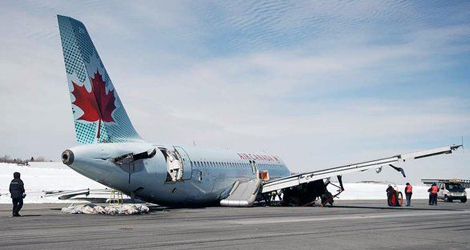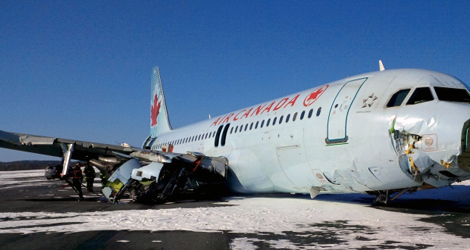On 29 March 2015, Air Canada flight AC624 Airbus Industrie A320-211 (registration C-FTJP, serial number 233) was on a scheduled flight from Toronto/Lester B. Pearson International Airport, Ontario, to Halifax/Stanfield International Airport, Nova Scotia, with 133 passengers and 5 crew members on board.
Air Canada flight AC624 started to descend about 0.2 nm from the FAF. The aircraft crossed the FAF at 2170 feet indicated altitude
At approximately 0030 Atlantic Daylight Time, while conducting a non-precision approach to Runway 05, the Air Canada flight AC624 severed power lines, then struck the snow-covered ground about 740 feet before the runway threshold.

Air Canada flight AC624
The aircraft continued airborne through the localizer antenna array, then struck the ground twice more before sliding along the runway. It came to rest on the left side of the runway, about 1900 feet beyond the threshold.
Air Canada flight AC624 was evacuated; 25 people sustained injuries and were taken to local hospitals.
The aircraft was destroyed.
There was no post-impact fire.
The emergency locator transmitter was not activated.
The accident occurred during the hours of darkness.
- Air Canada’s standard operating procedure (SOP) and practice when flying in flight path angle guidance mode was that, once the aircraft was past the final approach fix, the flight crews were not required to monitor the aircraft’s altitude and distance from the threshold or to make any adjustments to the flight path angle. This practice was not in accordance with the flight crew operating manuals of Air Canada or Airbus.
- As per Air Canada’s practice, once the flight path angle was selected and the aircraft began to descend, the flight crew did not monitor the altitude and distance from the threshold, nor did they make any adjustments to the flight path angle.
- The flight crew did not notice that the aircraft had drifted below and diverged from the planned vertical descent angle flight profile, nor were they aware that the aircraft had crossed the minimum descent altitude further back from the threshold.
- Considering the challenging conditions to acquire and maintain the visual cues, it is likely the flight crew delayed disconnecting the autopilot until beyond the minimum descent altitude because of their reliance on the autopilot system.
- The approach and runway lights were not changed from setting 4 to setting 5; therefore, these lights were not at their maximum brightness setting during the approach.
- The system to control the airfield lighting’s preset selections for brightness setting 4 was not in accordance with the NAV CANADA Air Traffic Control Manual of Operations requirement for the omnidirectional approach lighting system to be at its brightest settings.
- The limited number of visual cues and the short time that they were available to the flight crew, combined with potential visual illusions and the reduced brightness of the approach and runway lights, diminished the flight crew’s ability to detect that the aircraft’s approach path was taking it short of the runway.

Air Canada flight AC624
- The flight crew’s recognition that the aircraft was too low during the approach would have been delayed because of plan continuation bias.
- The aircraft struck terrain approximately 740 feet short of the runway threshold, bounced twice, and then slid along the runway before coming to a rest approximately 1900 feet beyond the runway threshold.
- At some time during the impact sequence, the captain’s head struck the glare shield because there were insufficient acceleration forces to lock the shoulder harness and prevent movement of his upper body.
- The first officer sustained a head injury and serious injury to the right eye as a result of striking the glare shield because the automatic locking feature of the right-side shoulder-harness inertia reel was unserviceable.
- A flight attendant was injured by a coffee brewer that came free of its mounting base because its locking system was not correctly engaged.
- Because no emergency was expected, the passengers and cabin crew were not in a brace position at the time of the initial impact.
- Most of the injuries sustained by the passengers were consistent with not adopting a brace position.
Download Report


To Bad the. Flight crew were not aware of the situation of the landing misinformation . The misfortune could have been avoided!